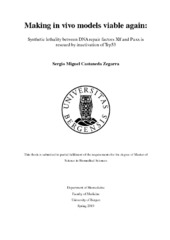| dc.description.abstract | Non-Homologous End-Joining (NHEJ) is the major DNA repair pathway that senses, processes and ligates DNA double strand breaks (DSBs) in higher eukaryotes, functionally throughout the cell cycle. The NHEJ involves four core and some accessory factors. The accessory factors are mainly required for resolving specific types of lesions. During NHEJ, core Ku70 and Ku80 subunits bind DSBs as a heterodimer and promote further recruitment of accessory factors (e.g., XLF, PAXX, MRI, DNA-PKcs, Artemis) and downstream core subunits XRCC4 and DNA ligase 4 (Lig4). Paralogue of XRCC4 and XLF (PAXX) has shown to be redundant with the XRCC4-Like Factor (XLF). Inactivation of Ku70 or Ku80 genes in mice results in immunodeficiency and high levels of genomic instability. While knockout of individual Xlf or Paxx in previously published mouse models revealed no overt phenotype, combined Xlf and Paxx deficiency results in late embryonic lethality (E15.5) due to extensive apoptosis in the central nervous system. These findings indicate important overlapping functions among the two proteins. The first aim of this project was to investigate if the lethality of Xlf-/-Paxx-/- mice can be rescued by inactivating one or two alleles of Trp53. This was done by crossbreeding Xlf+/-Paxx+/-Trp53+/- mice and verified by gene and protein expression. The second aim of this project was to describe the impact of Xlf and Paxx in immune system and general mouse development. Our Xlf-/-Paxx-/- mice with deficiency for one or two alleles of Trp53 were here found to be distinguishable from single knockout Xlf-/- and Paxx-/- and heterozygous mice in relation to growth and lymphoid cell counts in the spleen and thymus. B and T cell frequencies in the spleen and thymus of Xlf-/-Paxx-/-Trp53+/- mice were evaluated in order to determine precisely the effect of Xlf and Paxx inactivation on lymphocyte development. I detected no B cells in the spleens and thymi of double knockout mice. However, I detected CD4+ and CD8+ T cells in both organs, in addition to nearly normal CD4+CD8+ T cell frequency. Furthermore, Xlf-/-Paxx-/-Trp53+/- TFs were evaluated every 48 hours until the sixth day in order to identify the proliferative power of Xlf-/-Paxx-/- cells. Xlf-/-Paxx-/-Trp53+/- TFs showed a significantly reduced proliferation compared to heterozygous and single knockout controls. Additionally, an optimization of the T-FISH technique was established in order to identify genomic instability at the chromosomal level. Some technical improvements in the assay allowed me to identify that Xlf-/-Paxx-/-Trp53+/- mice possess high numbers of chromosomal/chromatid breaks compared to heterozygous and single knockout controls. However, the small number of used samples did not allow me to make a solid conclusion and more mice are required to complete the study. In conclusion, I demonstrated that inactivation of pro-apoptotic factor Trp53 rescues embryonic lethality of Xlf−/−Paxx−/− double knockout mice. | en_US |
